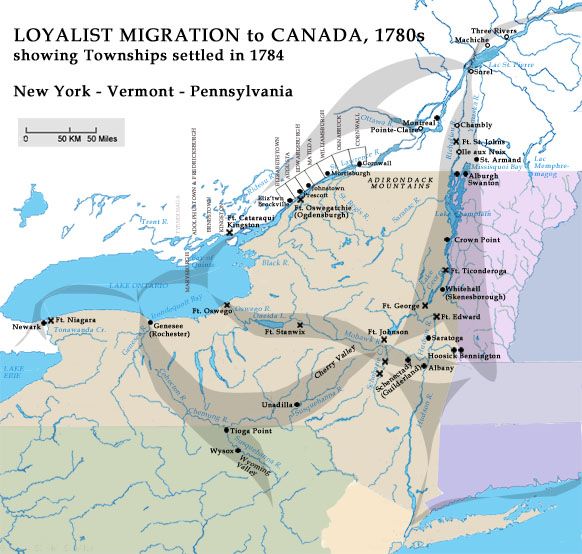Immigration to Canada
Movement of people from their home countries to settle
elsewhere is an essential part of Canada's history. In this country,
immigration has never been a factor of orderly population growth. She has
served and continues to serve as a catalyst for economic progress, as well as
reflecting Canadian attitudes and values. It has also been subjected, without
any qualms, to the country's own economic interests and often to outrageously discriminatory
policies on ethnic and racial grounds.
Loyalist immigration
The new British rulers, who would have liked the colony to
remain a quiet appendage to the Empire, soon found themselves obliged to accept
several thousand English-speaking settlers, most of whom were Protestants,
following the American War of Independence. Known as the Loyalists of the
United Empire, they are largely political refugees .
They are heading north not
by choice, but by obligation, either that they do not wish to become citizens
of the new American republic, or that they fear reprisals for publicly
supporting the British. For these Loyalists, who will form the nucleus of the
ruling class of the colony, Canada is a country of second choice. It will be
the same for countless people who will immigrate thereafter because they have
been forced to leave their homeland and access to other countries (often the
United States) is limited.
Loyalist immigration is not done without supervision or
support. The rulers and soldiers of the British Empire provide them with
property and distribute land to them. The hardships that settlers face are
softened by state intervention, a practice that will become common in Canada.
The great migration to the West
As the country's agricultural vocation is partly defined by
farming, Canada faces difficulties when arable land is scarce. After
Confederation , the country does not yet have a real industrial base, the
mortality rate is relatively low, the birth rate is high, and immigration is
small but continuous, especially in the British Isles, so that overpopulation
arise. The United States, which seems to have an unlimited
reserve of free arable land, attracts thousands of new immigrants and English
Canadians, while many French Canadians go to work in factories in New England
Towards the end of the 19th century, the territories that
are now part of the Prairies open to colonization. However, it is only after
the discovery of a market for the agricultural production of this region that
the settlement really starts there. The demand for agricultural products,
particularly durum wheat, coincides with the election of the Wilfrid Laurier
government , which immediately promotes the development of the West by
encouraging massive immigration. Clifford Sifton , new Minister of the Interior
and energetic man, is developing a new program of great significance. He
accepts, albeit with little enthusiasm, to welcome farmers who do not come from
the British Isles, northern Europe or the United States, and explains his
position:
"A vigorous peasant dressed in a skin coat of sheep, born on a
farm and whose ancestors have been farmers for ten generations, and a valiant
woman who gave him many children are good settlers ".
Nevertheless, Sifton's words, repeatedly reiterated, do not
exactly reflect the policy of the government. From 1896 until the 1930s,
Canadians, their political representatives and immigration officials were not
eager to welcome "peasants dressed in sheep's cloaks". Immigration policy
is not just about populating the Prairies quickly, it's part of the structure
of the British Empire that Sifton and the Canadian government believe, like
most English-speaking Canadians.
The traditional definition of the ideal immigrant could be
changed, but not radically transformed. Resolutely colonialist, the government
describes non-native immigrants from the British Isles as foreigners.
Resolutely North American, it excludes English-speaking white immigrants from
the United States from this category. The ideal immigrant is therefore a
British or American farmer with financial resources who wants to settle in the
West. Sifton and the government are probably just following the spirit of the
day, but Canadian immigration policy and public opinion are nonetheless racist .
Businessmen and railroad officials, predicting unlimited
global demand for Canadian resources, urge Sifton and immigration authorities
to increase the number of immigrants. Seeking a compromise between the fears
related to the racial question and the urgent need for farmers, we draw up a
list of immigrants in order of preference: British, Americans, French, Belgians
, Dutch , Scandinavians, Swiss , Finns , Russians , Austrians Hungarians, Germans , Ukrainians and Poles . Then come those who,
according to the government and the general population, are less assimilable,
less well-regarded: Italians , South Slavs, Greeks and Syrians
In addition, the federal government does not have a monopoly
on immigration. The British North America Act also gives provinces the power to
make decisions if they choose to manage the sector. Because of the growing
population of English Canada, as well as to curb, if not reverse, young rural
Quebeckers who are looking for jobs in New England manufacturing, Quebec is
setting up its own system. immigration. In collaboration with the federal
authorities, immigration officers are sent to New England to encourage French
Canadians to return home to work on marginal lands newly open to agriculture . This program has had mixed success, but Quebec
continues to define its own immigration priorities .
For Futher Information : Apply online BusinessVisa AustraliaWebsite



Comments
Post a Comment